 |
Bradley & Co. Ltd
(Beldray)
Mount Pleasant, Bilston |
 |
5. The Interwar Years
Mary Southall tells us that around 1920 - 1924 the
working hours of the firm were from 8.00 am to 5.30 pm Monday to Friday
and Saturday mornings. The firm was making its range of brass and
copper wares and general hollowware; with toilet pans for export to
South Africa and gas boilers as new products. "In the years
between 1920 and 1932 the firm suffered a depression as all other firms
did in this period. There was little unemployment at the firm as
at many other places; but these were hard times and all suffered because
of this. Between the period of 1932 - 1939 trade picked up a lot
and, compared to the depression, the firm went through a boom time.
The main products of the firm at this time were buckets, baths and
bowls, as by this time the skilled work which had previously been
carried out on the coppered ware was completely dying out".
That account, which Ms Southall almost certainly
collected from the oral tradition of the firm, is probably broadly
accurate but one suspects that the range of products was greater than
she indicates and that the gradual demise of the brass and copper art
metalwares was not caused by a lack of skill but by a change of fashion.
In fact Bradley's trade in these items survived a good deal longer
than that of their major competitors, including the local Joseph Sankey
& Sons.
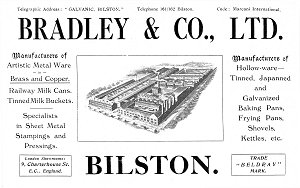 |
This advert (left) from 1920 lists their
products as art metalware, railway milk cans, tinned milk
buckets; tinned, japanned and galvanised frying pans,
shovels, kettles, etc.; and says that they are specialists
in stampings and pressings. (Most companies
offered to do such work for other companies to make fuller
use of equipment and labour). |
|
This advert, from the 1920s, shows Art
Metalware in brass, copper and electro-plate. The
reference to electro-plate is not clear.
There is also reference to household
hollowware, which they describe as galvanised, tinned and
japanned.
In both cases the items shown are
merely representative; the actual range was, in both cases,
much wider. |
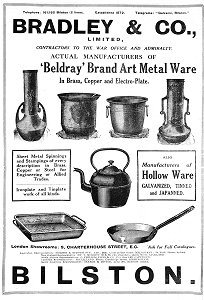 |
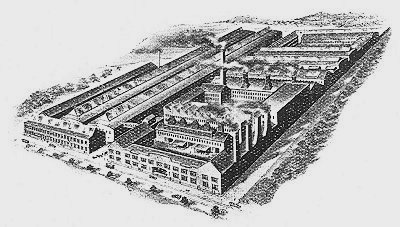 |
By now the factory had been largely rebuilt since its
early times as this picture from a 1920 advert shows.
Mary Southall provided a diagram of the works as they were
in 1920 (redrawn, below).
There is only a rough correspondence between the two
images. |
| It may be that, despite the dates given, Ms.
Southall has shown an earlier layout of the site.
It seems to consist of two main blocks (with a third,
much smaller, toilet block) but exactly where these
buildings lay is not clear. All one can say is that
Mount Pleasant is at the bottom, by the houses. It is
also odd that one building is marked as having a canteen on
its second floor. If this is right it must have been
an alternative facility to that which, by Ms Southall's
account, should have been part of the bowling green, tennis
court and social club complex.
Note the small shop allocated to copper; and the
blacksmith's shop, presumably mainly for wrought iron parts. |
 |
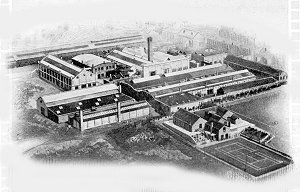 |
And this image, from an undated catalogue, shows
something else again. Note the tennis court, with the
bowling green to the right. Mount Pleasant runs across
the top right corner. This image has a greater air of
authenticity than the 1920 drawing above. |
| This drawing, from a later, undated catalogue, seems to
show a good deal of expansion, as well as two tennis courts.
Here Mount Pleasant runs across the bottom right corner. |
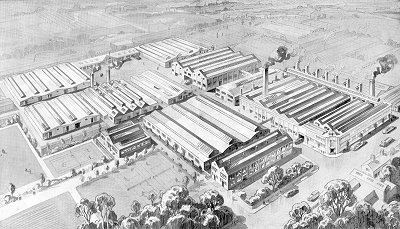 |
The following photos of the work's interior are undated
but are probably from the early part of the century. They almost
certainly show the same buildings as are on Mary Southall's maps.
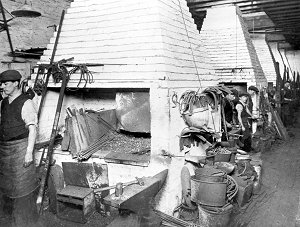 |
Forge hearths, at the first of
which the worker seems to be shaping bucket handles and then
fixing them to the bails. The handles, in straight
form, can be seen on the hearth and the finished buckets are
piled to the right. |
| Making kettles. The workers
to the right seem to be tinning the interiors of lids.
Note the number of women workers here. |
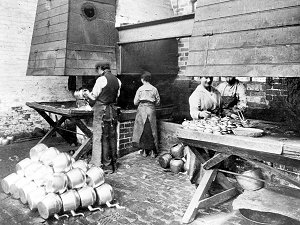 |
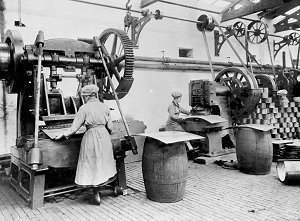 |
Sheet metal bending. The
fact that women are doing this work makes one wonder if this
was during World War One. |
| Five women all engaged in making
watering cans.
|
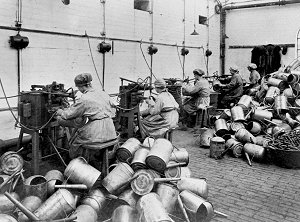 |
George Phillpott gives a more detailed account of the
later part of this period, staring in 1932. It will be noticed
that Mr. Phillpott mentions a far wider range of goods than does Ms
Southall.
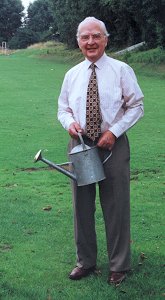
George Philpot, in much
later times, with a watering can for which he
made the tools. |
When I left school in December
1932, jobs were hard to come by. I was
lucky to be taken on by Bradley's and I started
there in January 1933, aged 14.
Conditions of employment were rather
different then to those of today. This is
not any criticism of Bradley's - it was common
practice among employers. They would take
on school leavers, such as myself, and when a
few years later they had to start paying them
adult wages, they would sack them and take on
other juveniles. I had been at work there
for several weeks before I found out that I had
been given the job from which a very good friend
had been dismissed (but there were no
recriminations).
My first job was to help to make coal
scuttles. They were called "Waterloos" because
they were shaped like the hats which soldiers
wore at the Battle of Waterloo.
After about twelve months I went into the
tool room as an apprentice tool maker.
This meant a drop in wages but it ensured that I
would still have a job after I reached the age
of 18 and that I would have a trade to my name. |
The tool room foreman was a man of most uncertain
temperament and, apparently because he frequently referred
to peoples as "proper Job's comforters", he was known as
Joey. He called everyone "Chile", in much the same way
that men today used the terms "mate" and "pal". I do
remember, however, one pearl of wisdom that he imparted to
me: "Remember this, Chile, the man who never made a
mistake, never made anything".
The company had an excellent reputation as makers of high
quality domestic wares, and the product range included
dustbins, buckets, household shovels, kettles of all sizes,
watering cans and a host of other items, including frying
pans by the thousands. Most of the products were galvanised,
though some were tinned and others, such as kettles and
coalscuttles, were black enamelled.
Some of these items we made then have now passed into
history such as the small hand bowl, with a wooden handle
about 6" long, with which the housewife would ladle the
water out of the washing tub when washing was done. Another
was the mortar bowl, a large steel receptacle shaped like a
pudding basin, which had been flattened somewhat, and about
24" in diameter. I never saw them in use but I always
understood that ladies in Africa carried them around on
their heads with goods and merchandise in them.
| Yet another was the egg bucket, a specially
designed bucket, the purpose of which was to
preserve eggs before the days of the fridge. A
substance called isinglass (which Bradley's did
not provide) was added to keep the eggs in good
shape.
Shown on the right is another of Beldray's
many products: the Rapid Vacuum Ice Cream
Freezer. It was like a huge vacuum flask.
You packed ice and salt in the bottom, round the
flask, then poured your ice cream mixture into
the flask at the top. Then you left it
until it froze. I think this device was
made in the 1920s or 30s.
Thousands upon thousands of paint cans were
made, some bearing proprietary names such as
"Walpamur".
|
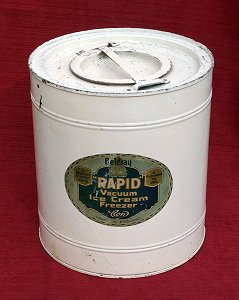 |
One shop made oval tin baths and in the tool room was a
machine which I believe was most unusual. It was a
lathe made by Maud & Turner. It machined not circular but
elliptical shapes on which tools were machined to produce
the bottoms of the oval baths and oval frying pans. The rise
and fall of the revolutions of the lathe head were achieved
by a series of cams and slides. Needless to say it did not
revolve very fast. |
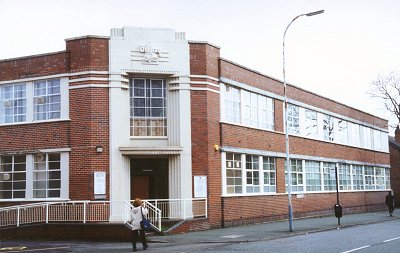 |
Sometime in the 1930s the frontage to Mount Pleasant was
entirely rebuilt with these offices. A splendid
example of the architecture of the period, they are now
locally listed. |
| The company retained these houses, which had apparently
been built by the company for what would now be called key
staff. Those on the right are to the north of the main
offices on Mount Pleasant and those below are to the south. |
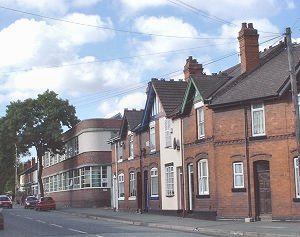 |
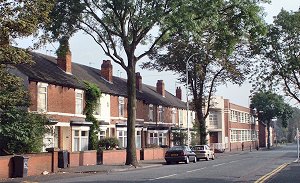 |
The south block was eventually auctioned off, in lots of
two or three houses at a time (but they now appear all to be
in individual ownership). The north block was sold in 1978
to help finance new factory buildings. Mrs. Winifred
Roberts (nee Barrett) bought hers direct from Beldray at
that time. She and her husband had lived in it for
years before, her husband being one of their employees.
But she could not buy it until after he husband had died. |
| Exhibition stand, of unknown
date but probably within this period. The event may have
been a British Industries Fair. The stand shows both art metalware
and galvanised goods, including watering cans, baths, boilers, well
buckets and a milk churn.
Photo by courtesy of Jaap Arriens.
|
 |
|


















